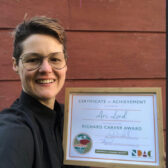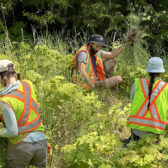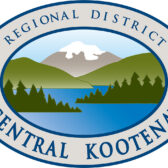COMMENT: Lack of dropped antlers and deer bones a bad sign in Boundary
I have been following hounds the last five weeks and in the process have walked a significant distance in the deer winter range and only on one occasion did I find the bones of a deer. Bones and dropped antlers for centuries have been a strong indicator of a healthy deer herd. Remember for decades the Boundary had the largest deer herd in the province.
Bones and dropped deer antlers were always a common sight until the extremely hard winter of 1996-97 and the dramatic increase in the politicalization of wildlife management by both Premier Glen Clark and Premier Gordon Campbell that has resulted in deer seasons and bag limits that have no connection to sustainable responsible wildlife management.
A meeting of hunters, BC Wildlife members and biologists was held at the Rock Creek Wildlife Hall May 10th for the specific purpose of convincing grey haired hunters that the BCWF agenda of supporting long deer hunting seasons on both the whitetail and mule deer bucks is scientifically sound as is the three week whitetail doe season.
The spring field counts of deer north of Rock Creek including the West Kettle drainage were once again within the parameters of field counts done for many years; 900 plus. Evidently counts are typically between 800-1200 deer. Nevertheless the grey haired hunters who hunt the West Boundary have witnessed a steep decline in the sightings of deer during the hunting season and likewise a steep decline in the harvesting of mature bucks.
Lee Cudworth, a retired logging contractor and ardent hunter who was raised in Greenwood reminded everyone at the meeting that you can now drive a hundred miles an hour from Greenwood to Kelowna because you no longer see deer!
The spring deer count on the Gilpin grasslands, the largest ungulate winter range in the East boundary (Greenwood, Grand Forks and Christina Lake) was once again within parameters of recent years, 100 whitetail and 100 mule deer. Pathetic when you remember the Freedom of Information letter May 1986 by Regional Manager, Zeke Withler that states Fish & Wildlife staff counted 962 deer and believed for every deer they counted they missed one therefore they believed there were 1100 whitetail and 900 mule deer on Gilpin.
The deer counts are not telling the true story, a point easily made by anyone who takes the time to talk to credible landowners and hunters. In our guide area which we know extremely well the issue is the secondary winter ranges that do not have large south facing slopes. All of the winter ranges up the Granby, Phoenix, Christina Lake and Boundary Creek are the victims of the suppression of forest fires that has resulted in the loss of openings critical to wintering ungulates. Many shrubs critical to wintering ungulates are not shade tolerant and therefore the number of deer on these winter ranges is extremely low by historic standards which is a major reason spring counts are not telling the true story. In other words the deer counted literally are what is left of the Boundary deer herd.
Pioneers Gordon and Howard Bryant now gone, 15-20 years ago told me a couple of times that they counted 232 deer one spring between Glover and Fresh Creek. Both creeks are within the much larger Pass Creek watershed 15 miles north of Grand Forks on the west side of the North Fork Valley. J.J. Rossi, another pioneer now gone and neighbor of Howard and Gordon Bryant told me that there used to be 75 deer winter on the slopes adjacent to his ranch. Mmost of the deer these pioneers counted were mule deer which province wide are in steep decline. The spring count to-day in the same area is approximately 25.
A recent short film on the Documentary Channel by the National Film Board showcased Grand Forks as a seed producing area in our province between World War I and World War II. The panoramic view of the Gilpin Grasslands is a reminder that 70-80 years ago most trees currently on Gilpin’s south facing slopes did not exist.
Jesse Zeeman, a BC Wildlife Federation biologist made a presentation titled “Do We Manage Wildlife or do we Manage the Hunter”. His thesis is that the deterioration of the quality of important ungulate habitat is a strong limiting factor in healthy sustainable wildlife populations. No disagreement there but he strongly believes it is important to first and foremost manage the hunter and not the wildlife resource which is the divide that the BCWF will never bridge with credible hunters.
Pat Kelly did a good job of describing the meeting in an article that appeared in The Boundary Creek Times May 15th. Pat’s article does remind us that even though there are more agendas on our land base than ever that have no respect for wildlife the BC Liberal Government continues to reduce the province’s wildlife management budget.
Once again the argument came forward at the meeting that the total revenue from hunting is only 25 million dollars and therefore wildlife does not have economic significance in the political scheme of things. I am not going to argue the numbers but the BC Liberal Government like the Glen Clark NDP Government before them have put pressure on the director of wildlife to support their agenda of increasing hunting opportunity which probably had more to do with supporting their agriculture friends especially ranchers, than the BC Wildlife Federation agenda of increasing hunting opportunity.
One of the hunters I spoke to last fall who is well known in the Cranbrook area defended former Director of Wildlife, Ian Hatter in response to my criticism of population estimates by Ian and his colleagues that are one of the major reasons the province’s wildlife resource has a grim future. His rebuttal was that MLA Bill Bennett and colleagues had threatened Ian that if he did not co-operate and support their agenda then the wildlife management bureaucracy would be downsized. Obviously these comments were made after the 2005 provincial election the start of Premier Campbell’s uber right vision of renewable resource management. To-day there is no bureaucracy or budget to oversee the public interest in the management of parks, water, timber, grassland and wildlife.
I cannot prove Bill Bennett threatened Ian Hatter but I will send you two newsletters in the near future that showcase the indictment of the BC Liberal Government: a report card from hunters and guides from different regions of our province who are all critical of wildlife management; a summary of my journey with politicians, bureaucrats and agriculture interests, primarily ranchers that showcase their contempt for the grassland ecosystem and wildlife!

























